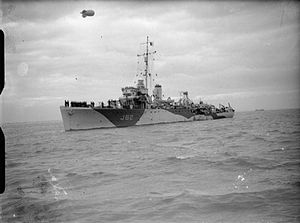
HMS Peterhead was a Bangor-class minesweeper built for the Royal Navy during the Second World War.

HMS Speedy was one of 21 Halcyon-class minesweepers built for the Royal Navy in the 1930s.

HMS Hebe was one of 21 Halcyon-class minesweepers built for the Royal Navy in the 1930s. Commissioned in 1936, Hebe served during World War II, notably taking part in the Dunkirk evacuation in 1940 and then serving in the Mediterranean, carrying out minesweeping operations from Malta. After taking part in several operations, including Operations Harpoon and Torch, and the invasion of Pantelleria, Hebe was sunk by a mine off Bari in November 1943, with the loss of 37 of the vessel's crew.

HMS Hythe was a Bangor-class minesweeper built for the Royal Navy during the Second World War.

HMS Halcyon was the lead ship in her class of minesweepers built for the Royal Navy in the 1930s. The vessel was launched on 20 December 1933 and was used as a convoy escort and during the landing operations during the Invasion of Normandy during World War II. The ship was sold for scrapping in 1950.
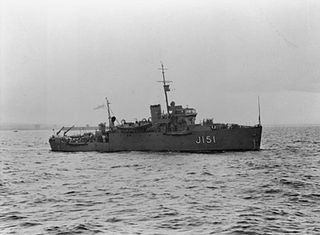
HMS Clacton was a Bangor-class minesweepers built for the Royal Navy during the Second World War.
HMS Felixstowe was a Bangor-class minesweepers built for the Royal Navy during the Second World War.

HMS Cromer was a Bangor-class minesweepers built for the Royal Navy during the Second World War.
HMIS Rohilkhand (J180) was a Bangor-class minesweeper built for the Royal Navy, but transferred to the Royal Indian Navy (RIN) during the Second World War.
HMIS Kumaon (J182) was a Bangor-class minesweeper built for the Royal Navy, but transferred to the Royal Indian Navy (RIN) during the Second World War.
HMIS Carnatic (J182) was a Bangor-class minesweeper built for the Royal Navy, but transferred to the Royal Indian Navy (RIN) during the Second World War.
HMIS Rajputana (J197) was a Bangor-class minesweepers built for the Royal Navy, but transferred to the Royal Indian Navy (RIN) during the Second World War.
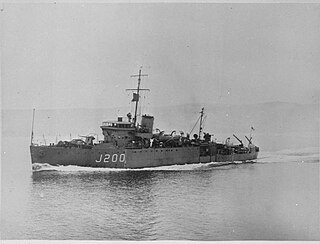
HMIS Orissa (J200) was a Bangor-class minesweepers built for the Royal Navy, but transferred to the Royal Indian Navy (RIN) during the Second World War.
HMIS Bihar (J247) was a Bangor-class minesweeper built for the Royal Navy. It transferred to the Royal Indian Navy (RIN) during the Second World War.
HMIS Konkan (J228) was a Bangor-class minesweepers built for the Royal Navy, but transferred to the Royal Indian Navy (RIN) during the Second World War.
HMIS Deccan (J129) was a Bangor-class minesweepers built for the Royal Navy, but transferred to the Royal Indian Navy (RIN) during the Second World War.
HMS Lyme Regis was a Bangor-class minesweeper built for the Royal Navy during the Second World War.

HMS Sharpshooter was a Halcyon-class minesweeper of the British Royal Navy. Built at Devonport Dockyard, Sharpshooter was completed in 1937. She served through the Second World War, acting both in her designed role as minesweeper and as a convoy escort, escorting several Arctic convoys. She took part in the evacuation from Dunkirk in 1940, and sank the German submarine U-655 in 1942.
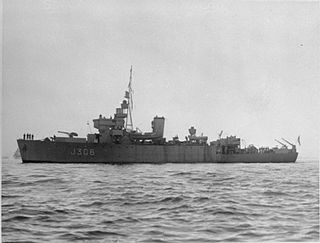
HMS Fly (J306) was a reciprocating engine-powered Algerine-class minesweeper during the Second World War. She survived the war and was sold to Iran in 1949 as IISPalang.
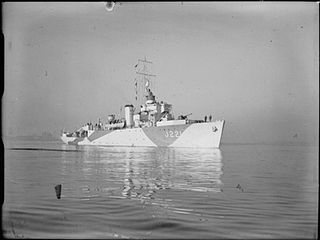
HMS Onyx (J221) was a turbine engine-powered Algerine-class minesweeper during the Second World War.
